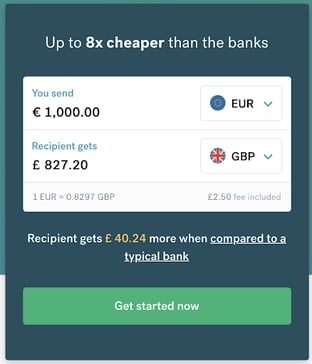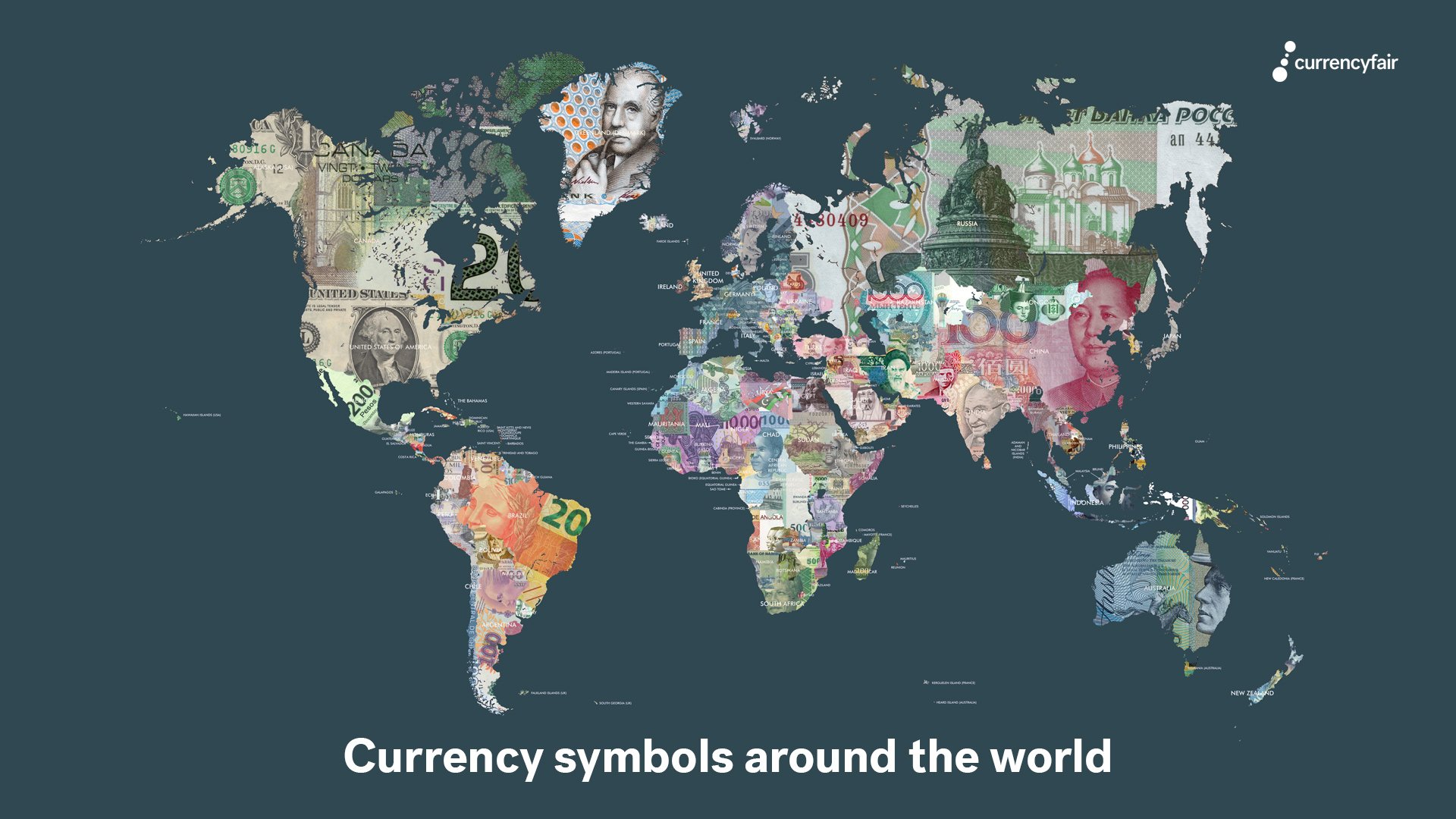Currency symbols around the world
According to the International Organization for Standardization (ISO), there are almost 300 currencies circulating the world, and every world currency has its own distinct codes, set by ISO, and currency symbol. ISO is the same organisation responsible for the creation of the International; Bank Account Number (IBAN), and we have previously written about what an IBAN is and how to find it. IBAN was introduced as a simple solution to translate bank account details into a machine-readable alphanumeric format to better facilitate international money transfers. Similarly, currency codes and symbols create a unified language to connect the various currencies around the world in a universally understandable way.
If you need to handle multiple currencies or send money abroad for personal or business reasons, CurrencyFair can help. It’s up to eight times cheaper to send money abroad with CurrencyFair compared to traditional banks, and our world-class customer support team is available if you have any questions.
What’s the difference between a currency code and a currency symbol?
ISO publishes and maintains the “ISO 4217” code list, a list with both alphabetic and numeric codes to represent currencies around the world. It’s used to establish internationally recognized codes and reduce confusion and errors when dealing with different currencies.
Each currency has a three-letter alphabetic code and corresponding three-digit numeric code. You may see the alphabetic code when you’re comparing the exchange rates for different currencies. For example, below you’ll see EUR/GBP in a quote using CurrencyFair’s Exchange Rate Calculator for the euro against the British pound. EUR is the three-letter ISO currency code for the euro, and GBP is the code for the British pound, created by ISO based on the first letters of “Great Britain” and “pound”.

Rates accurate as of 12:30, 19 January 2022.
ISO also maintains numeric codes for currencies, but you’re less likely to run into these in your day-to-day currency needs. According to ISO, numeric currency codes are used in countries that do not use Latin scripts and for automated systems, such as the computer programmes used internally by banks and fintech companies.
A currency symbol, on the other hand, is a graphic symbol used to represent a currency's name. Different currency symbols are used for different currencies as a convenient shorthand to reference amounts of money, for example, using “€10” rather than writing out “ten euros”. A currency symbol may also be referred to as a currency sign, or less commonly as a money symbol. For some currencies, particularly emerging currencies, letters may be used in place of a graphic symbol. For example, the currency symbol for the Guatemala Quetzal is simply “Q”.
How do I use different currency symbols around the world?
When you use a currency symbol to denote an amount of money, the position of the symbol varies based on the language in which it appears. Currency symbols are generally placed either before or after the numerical digits, although in some countries they may be placed in the middle of the figure instead of a decimal point.
For example, for many English-speaking countries like England, Ireland and Australia, the currency symbol precedes the amount with no space in between. Placing the currency symbol after the amount is seen in many non-English speaking countries, preceded by a space after the amount.
In Cape Verde, the $ symbol is typically used to separate decimals; for example, 20$00 indicates 20 escudos. Its official currency is the Cape Verde escudo (CVE).
|
Currency symbol position in Ireland |
Currency symbol position in France |
Currency symbol position in Cape Verde |
|
€100.50 |
100.50 € |
100$50 |
In cases where the same currency symbol is used to represent multiple currencies, as in the case with the dollar symbol, the symbol may include a country prefix, such as Mex$ for Mexican peso, or US$ for U.S. dollar.
Currency symbols around the world
The following is a list of the currencies of different countries with symbols and currency codes. This isn’t a fully exhaustive list, as with the introduction of new global currencies and cryptocurrencies there are additions to be made all the time. For example, the cryptocurrency Bitcoin, invented in 2008, is represented by the ₿ symbol.
| Country and currency | Currency symbol | Currency code (ISO) |
| Afghanistan Afghani | ؋ | AFN |
| Albania Lek | Lek | ALL |
| Algeria Dinar | دج | DZD |
| Angola Kwanza | Kz | AOA |
| Argentina Peso | $ | ARS |
| Armenia Dram | ֏ | AMD |
| Aruba Guilder | ƒ | AWG |
| Australia Dollar | $ | AUD |
| Azerbaijan Manat | ₼ | AZN |
| Bahamas Dollar | $ | BSD |
| Bahrain Dinar | .د.ب or BD | BHD |
| Bangladesh Taka | ৳ | BDT |
| Barbados Dollar | $ | BBD |
| Belarus Ruble | Br | BYN |
| Belize Dollar | BZ$ | BZD |
| Bermuda Dollar | $ | BMD |
| Bhutan Ngultrum | Nu. | BTN |
| Bolivia Bolíviano | $b | BOB |
| Bosnia and Herzegovina Convertible Mark | KM | BAM |
| Botswana Pula | P | BWP |
| Brazil Real | R$ | BRL |
| Brunei Darussalam Dollar | $ | BND |
| Bulgaria Lev | лв | BGN |
| Burundi Franc | FBu | BIF |
| Cambodia Riel | ៛ | KHR |
| Canada Dollar | $ | CAD |
| Cape Verde Escudo | $ as a decimal seperator or Esc | CVE |
| Cayman Islands Dollar | $ | KYD |
| Chile Peso | $ | CLP |
| China Yuan Renminbi | ¥ | CNY |
| Colombia Peso | $ | COP |
| Communauté Financière Africaine (BCEAO) Franc | CFA | XOF |
| Communauté Financière Africaine (BEAC) CFA Franc BEAC | FCFA | XAF |
| Comorian Franc | KMF | KMF |
| Comptoirs Français du Pacifique (CFP) Franc | ₣ | XPF |
| Congo/Kinshasa Franc | Franc | CDF |
| Costa Rica Colon | ₡ | CRC |
| Croatia Kuna | kn | HRK |
| Cuba Convertible Peso | CUC$ | CUC |
| Cuba Peso | ₱ | CUP |
| Czech Republic Koruna | Kč | CZK |
| Denmark Krone | kr | DKK |
| Djibouti Franc | Fdj | DJF |
| Dominican Republic Peso | RD$ | DOP |
| East Caribbean Dollar | $ | XCD |
| Egypt Pound | £ | EGP |
| El Salvador Colon | $ | SVC |
| Eritrea Nakfa | Nfk (Latin Script) ናቕፋ (Ethiopic Script) نافكا (Arabic Script) | ERN |
| eSwatini Lilangeni | E | SZL |
| Ethiopia Birr | Br or ብር | ETB |
| Euro Member Countries | € | EUR |
| Falkland Islands (Malvinas) Pound | £ | FKP |
| Fiji Dollar | $ | FJD |
| Gambia Dalasi | D | GMD |
| Georgia Lari | GEL or ლ | GEL |
| Ghana Cedi | ¢ | GHS |
| Gibraltar Pound | £ | GIP |
| Guatemala Quetzal | Q | GTQ |
| Guernsey Pound | £ | GGP |
| Guinea Franc | FG | GNF |
| Guyana Dollar | $ | GYD |
| Haiti Gourde | G | HTG |
| Honduras Lempira | L | HNL |
| Hong Kong Dollar | $ | HKD |
| Hungary Forint | Ft | HUF |
| Iceland Krona | kr | ISK |
| India Rupee | ₹ | INR |
| Indonesia Rupiah | Rp | IDR |
| International Monetary Fund (IMF) Special Drawing Rights | XDR | XDR |
| Iran Rial | ﷼ | IRR |
| Iraq Dinar | ع.د | IQD |
| Isle of Man Pound | £ | IMP |
| Israel Shekel | ₪ | ILS |
| Jamaica Dollar | J$ | JMD |
| Japan Yen | ¥ | JPY |
| Jersey Pound | £ | JEP |
| Jordan Dinar | د. | JOD |
| Kazakhstan Tenge | лв | KZT |
| Kenya Shilling | KSh | KES |
| Korea (North) Won | ₩ | KPW |
| Korea (South) Won | ₩ | KRW |
| Kuwait Dinar | KD or د.ك | KWD |
| Kyrgyzstan Som | лв | KGS |
| Laos Kip | ₭ | LAK |
| Lebanon Pound | £ | LBP |
| Lesotho Loti | L | LSL |
| Liberia Dollar | $ | LRD |
| Libya Dinar | LD or ل.د | LYD |
| Macau Pataca | MOP$ | MOP |
| Macedonia Denar | ден | MKD |
| Madagascar Ariary | Ar | MGA |
| Malawi Kwacha | MK | MWK |
| Malaysia Ringgit | RM | MYR |
| Maldives (Maldive Islands) Rufiyaa | Rf | MVR |
| Mauritania Ouguiya | UM | MRU |
| Mauritius Rupee | ₨ | MUR |
| Mexico Peso | $ | MXN |
| Moldova Leu | L | MDL |
| Mongolia Tughrik | ₮ | MNT |
| Morocco Dirham | د.إ | MAD |
| Mozambique Metical | MT | MZN |
| Myanmar (Burma) Kyat | K | MMK |
| Namibia Dollar | $ | NAD |
| Nepal Rupee | ₨ | NPR |
| Netherlands Antilles Guilder | ƒ | ANG |
| New Zealand Dollar | $ | NZD |
| Nicaragua Cordoba | C$ | NIO |
| Nigeria Naira | ₦ | NGN |
| Norway Krone | kr | NOK |
| Oman Rial | ﷼ | OMR |
| Pakistan Rupee | ₨ | PKR |
| Panama Balboa | B/. | PAB |
| Papua New Guinea Kina | K | PGK |
| Paraguay Guarani | Gs | PYG |
| Peru Sol | S/. | PEN |
| Philippines Peso | ₱ | PHP |
| Poland Zloty | zł | PLN |
| Qatar Riyal | ﷼ | QAR |
| Romania Leu | lei | RON |
| Russia Ruble | ₽ | RUB |
| Rwanda Franc | FRw, RF, R₣ | RWF |
| Saint Helena Pound | £ | SHP |
| Samoa Tālā | $ (sometimes SAT, ST or T) | WST |
| São Tomé and Príncipe Dobra | Db | STN |
| Saudi Arabia Riyal | ﷼ | SAR |
| Seborga Luigino | SPL | SPL |
| Serbia Dinar | Дин. | RSD |
| Seychelles Rupee | ₨ | SCR |
| Sierra Leone Leone | lei | SLL |
| Singapore Dollar | $ | SGD |
| Solomon Islands Dollar | $ | SBD |
| Somalia Shilling | S | SOS |
| South Africa Rand | R | ZAR |
| Sri Lanka Rupee | ₨ | LKR |
| Sudan Pound | ج.س. | SDG |
| Suriname Dollar | $ | SRD |
| Sweden Krona | kr | SEK |
| Switzerland Franc | CHF | CHF |
| Syria Pound | £ | SYP |
| Taiwan New Dollar | NT$ | TWD |
| Tajikistan Somoni | ЅM | TJS |
| Tanzania Shilling | TSh | TZS |
| Thailand Baht | ฿ | THB |
| Tonga Pa'anga | T$ | TOP |
| Trinidad and Tobago Dollar | TT$ | TTD |
| Tunisia Dinar | DT or د.ت | TND |
| Turkey Lira | ₺ | TRY |
| Turkmenistan Manat | T | TMT |
| Tuvalu Dollar | $ | TVD |
| Uganda Shilling | USh | UGX |
| Ukraine Hryvnia | ₴ | UAH |
| United Arab Emirates Dirham | د.إ | AED |
| United Kingdom Pound | £ | GBP |
| United States Dollar | $ | USD |
| Uruguay Peso | $U | UYU |
| Uzbekistan Som | лв | UZS |
| Vanuatu Vatu | VT | VUV |
| Venezuela Bolívar | Bs | VEF |
| Viet Nam Dong | ₫ | VND |
| Yemen Rial | ﷼ | YER |
| Zambia Kwacha | ZK | ZMW |
| Zimbabwe Dollar | Z$ | ZWD |
Photo by Jason Leung on Unsplash. This information is correct as of 20 January 2021. This information is not to be relied on in making a decision with regard to an investment. We strongly recommend that you obtain independent financial advice before making any form of investment or significant financial transaction. This article is purely for general information purposes.
Meet the NHS medical director sailing through retirement
Related Articles
Search
Popular Posts
-
Currency symbols around the world
February 9, 2022 -
International Money Transfer Companies Compared: UK
December 11, 2019 -
#CommunityStory: Employment in a borderless world
December 11, 2017


